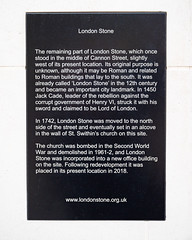

London Stone
thing and stone
Aged unknown
Wikidata WikipediaLondon Stone is a historic landmark housed at 111 Cannon Street in the City of London. It is an irregular block of oolitic limestone measuring 53 × 43 × 30 cm (21 × 17 × 12"), the remnant of a once much larger object that had stood for many centuries on the south side of the street. The name "London Stone" was first recorded around the year 1100. The date and original purpose of the Stone are unknown, although it is possibly of Roman origin. There has been interest and speculation about it since the medieval period, but modern claims that it was formerly an object of veneration, or has some occult significance, are unsubstantiated.
DbPedia
Commemorated on 1 plaque
London Stone The remaining part of London Stone, which once stood in the middle of Cannon Street, slightly west of its present location. Its original purpose is unkown, although it may be Roman and related to Roman buildings that lay to the south. It was already called 'London Stone' in the 12th century and became an important city landmark. In 1450 Jack Cade, leader of the rebellion against the corrupt government of Henry VI, struck it with his sword and claimed to be Lord of London. In 1742, London Stone was moved to the north side of the street and eventually set in an alcove in the wall of St. Swithin's church on this site. The church was bombed in the Second World War and demolished in 1961-2, and London Stone was incorporated into a new office building on the site. Following redevelopement it was placed in its present location in 2018.
111 Cannon Street, London, United Kingdom where it was
